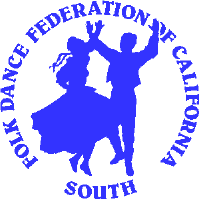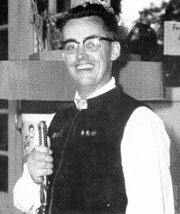
|
Folk Dance Federation of California, South, Inc.
Historical Notes |

|
CLICK IMAGE TO ENLARGE
The Swedish "Polska," in 3/4 time but older than and differing from the Waltz, and not to be confused with the even more modern 2/4-time "Polka," constitutes the rhythmic framework for the greatest share of all folk song, instrumental, and dance melodies of Sweden. American folk dancers are best acquainted with this rhythm through the Hambo, however, it is also found in such other Swedish dances as Snurrbocken, Fyramannadans, and Daldans, and is closely related to the Norwegian Springpols. Yet, these few dances are but a shadow of what the Polska must have encompassed during its heyday of over two centuries from the end of the 1500s to the middle of the 1800s. In those days, everyone in Sweden who danced, danced the Polska in some form or another.
But times and fashions change, and in the past century and a quarter, the Waltz, the Schottische, the Polka, the Foxtrot, the Tango, the Swing, and now Rock-'n-Roll and the Twist, have progressively replaced one another as "the dance of the hour." Still, none of them can claim anything like the many generations of unchallenged supremacy enjoyed by the Polska, with its steady, subtly compelling triple-beat.
Today, however, except for a relatively few survivals (notably the Hambo, the venerable old Swedish Polska (Gammal Polska) is virtually forgotten as a "dance of the people." Only the country fiddlers – the "spelman" – have managed to preserve a significant part of the rich treasure of Polska music, and pass it on to an increasingly grateful latter-day folk.
Old Swedish Polska (Gammal Polska)
This is a traditional couple dance from Sweden. Through the initiative of certain Swedish country fiddlers and folk dance instructors, a number of all-but-forgotten "Polska" dances have been brought to light in Sweden in just the last few years. Each area of the country, of course, has had its own special brand or brands of the dance, differing to some extent in footwork and pattern, but especially in character and styling, depending upon the music typical for that district. But whether these dances come from the south, central, or north parts of the land, certain similarities and underlying fundamental "constants" seem to be evident. For one thing, a Polska step in a couple dance nearly always made one full revolution in one measure (unlike the Waltz, Polka, or Two-step, which take two measures for full turn). And, consequently, each step began on the same foot (again, contrasting with the Waltz, et cetera).
Furthermore, the woman's step is consistently a "follow-up" of the man's step, so that in effect they dance the same step, but each at a different point in the music. Not the least in significance is the fact that almost all Polska steps, regardless of which foot or point in the step-pattern they begin on, follow a consistant, nearly rigid, order of progression. Thus, by knowing that the man begins on his left foot, for instance, one can predict not only the rest of his step, but the woman's step as well. This "rule of foot" has proved very helpful in reconstructing nearly-vanished Polska dances.
One Polska can have no specific name other than "Old Polska" (Gammal Polska). It is to be found the most basic of the Polska steps as used in a partner turn. Actually, this turn is but an "extension" of the straight walk forward, all in syncopated Polska rhythm; one merely adapts the open step to provide for easy, natural balance in the closed turn, without ever losing the basic "one, ---, three, one, ---" weight-shift pattern. Actually, the whole thing is so simple, it is astounding.
Here, it might be said, is a prototype of the many Polska steps and dance forms which developed in northern Scandinavia over the centuries. Alert dancers will recognize it as essentially the same footwork as that used in the Snurrbocken turn, a step sometimes called "Delsbo-polska" (after a district in Häsingland or simply "left foot Polska," referring to the man's step). The same step is found in a "Bakmes-polska" from western Dalarna in Sweden, and in the exhilarating "Rørospols" from Østerdalen in Norway.
As is the case of all couple Polskas, the man is the master of the dance, and he must lead it, firmly, thoroughly, and unerringly. The woman in effects gets a "free ride." If the man knows his steps well, the woman need only "let him drive," and the result will be a satisfying one. Gammal Polska is surely not a complex dance, but, like the Viennese Waltz, it is something that craves patience and practice, for it is a subtle thing. Once mastered, it can be one of the most relaxing yet satisfying of couple dances, and the conscientious dancer will be amply rewarded for his time.
Reprinted from the 1962 University of the Pacific (Stockton) Folk Dance Camp syllabus.